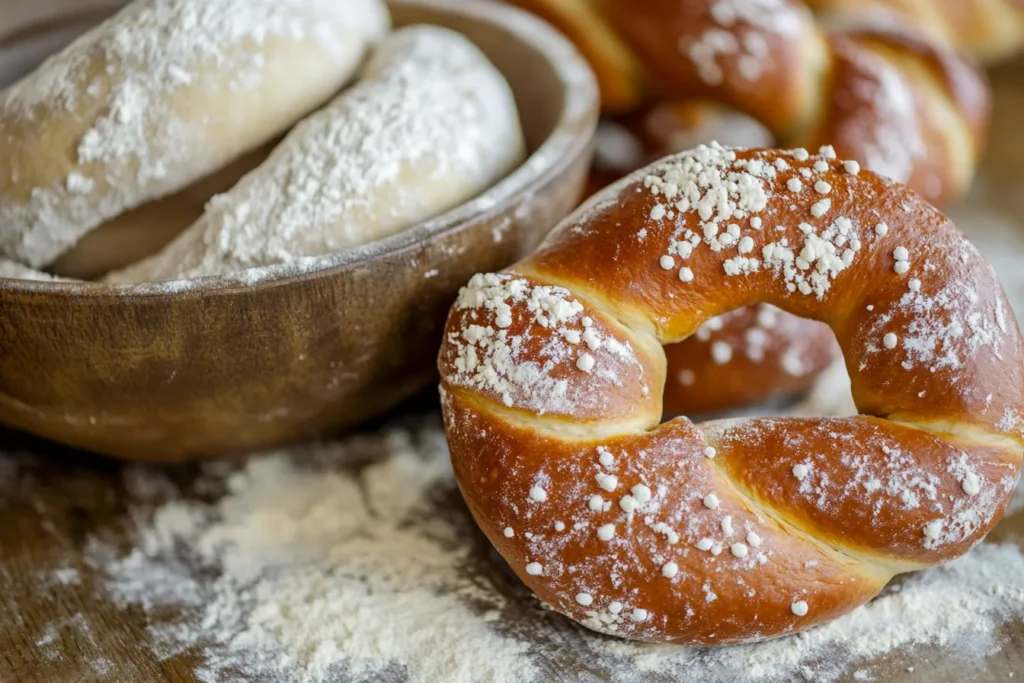Have you ever wondered if pretzel dough and pizza dough are essentially the same thing? While they might seem similar on the surface—both relying on yeast, flour, water, and salt—their differences make them unique. This article dives deep into the distinctions, exploring their ingredients, preparation methods, flavor profiles, and even how they’re used. If you’ve ever been curious about substituting one for the other or understanding what makes them special, this guide is for you!
Understanding the Basics of Dough
What is Pizza Dough?
Pizza dough is a classic yeast-based dough that’s versatile and easy to make. It’s known for being stretchy, pliable, and forgiving, making it ideal for the crispy-yet-soft texture of a perfect pizza crust. The foundation of pizza dough lies in high-gluten flour, water, yeast, salt, and sometimes olive oil. A hallmark of pizza dough is its ability to develop a chewy consistency, perfect for holding up all those delicious toppings.
When made correctly, pizza dough achieves a balance between crispness and chewiness. Thanks to its relatively neutral flavor, it works well for other recipes too, such as breadsticks or calzones.
What is Pretzel Dough?
Now, let’s talk about pretzel dough. At first glance, it might seem similar to pizza dough. It also starts with yeast, flour, water, and salt. However, the preparation process introduces a defining twist: a baking soda bath. This crucial step gives pretzel dough its signature dark, glossy crust and distinctive, slightly alkaline taste.
Pretzel dough is less elastic than pizza dough, making it easier to shape into those iconic twists. Additionally, its flavor leans more savory and robust, often complemented by toppings like coarse salt or seeds. Pretzel dough’s dense texture sets it apart, providing a chewy, satisfying bite.
Key Ingredients in Pizza Dough vs. Pretzel Dough
Core Ingredients of Pizza Dough
When comparing pizza dough and pretzel dough, one of the most striking differences lies in their ingredients. Pizza dough typically consists of just a few essential ingredients: flour, water, yeast, salt, and olive oil. The primary goal of pizza dough is to create a soft and chewy texture. The high-gluten flour used is key in achieving that chewy yet crispy crust that holds up against sauce, cheese, and toppings.
Some variations of pizza dough may include sugar or honey, which helps feed the yeast and allows the dough to rise faster. Additionally, olive oil is sometimes added for extra richness and to contribute to the dough’s flavor. However, regardless of the specific recipe, pizza dough is known for its subtle flavor and flexibility, allowing it to be paired with a wide range of toppings.

Distinctive Ingredients in Pretzel Dough
Pretzel dough, on the other hand, has a more specialized ingredient list. While it shares the basics of flour, water, yeast, and salt with pizza dough, it takes a distinct turn when it comes to its preparation and the use of an alkaline solution—typically a baking soda bath—which is essential to achieving that signature pretzel crust.
This bath of boiling water and baking soda gives pretzels their deep, dark color and unique glossy finish. It also plays a role in enhancing the pretzel’s texture, resulting in a chewy exterior with a slightly crunchy bite. While pizza dough does not undergo such a process, pretzel dough requires this extra step to achieve its classic characteristics. Additionally, pretzel dough typically lacks the richness of oil or sugar that’s often found in pizza dough, contributing to its firmer, denser texture.
Preparation and Technique Differences
Kneading and Rising for Pizza Dough
The preparation of pizza dough is relatively simple and straightforward. After mixing the ingredients, the dough is kneaded for a few minutes to develop the gluten. Gluten is what gives pizza dough its chewy and elastic texture, making it easier to stretch into a thin crust. Once the dough is kneaded, it’s left to rise, typically for about an hour, until it has doubled in size. This slow rise contributes to the dough’s airy and light consistency.
Pizza dough can also be prepared ahead of time and left to ferment overnight in the refrigerator, which deepens its flavor. Once it’s ready, it’s stretched by hand or with a rolling pin, and the pizza crust is ready to be topped and baked.
Special Techniques in Pretzel Dough Preparation
The preparation of pretzel dough follows a more complex process. After the ingredients are mixed and kneaded, the dough is allowed to rise, just like pizza dough. However, what sets pretzel dough apart is the next crucial step: the baking soda bath. The pretzels are briefly boiled in a solution of water and baking soda before being baked. This step is what gives pretzel dough its characteristic crust and color. The high pH from the baking soda promotes the Maillard reaction, which is responsible for the deep, golden-brown color and glossy sheen.
Unlike pizza dough, which is usually shaped into round discs or squares, pretzel dough is shaped into twisted forms or sticks. This gives pretzels their iconic appearance and is part of what makes them stand out as a snack or treat. After the baking soda bath, the pretzels are sprinkled with coarse salt, adding an extra layer of flavor and texture that distinguishes pretzel dough from the more neutral-tasting pizza dough.
Flavor Profiles and Texture Comparisons
Flavor and Texture of Pizza Dough
When it comes to pizza dough, the flavor is designed to be subtle, allowing the toppings to shine. Pizza dough has a mildly savory taste with a hint of tanginess, especially if it’s been allowed to ferment overnight. This fermentation process can bring out a richer, slightly yeasty flavor, making it the perfect canvas for sauces, cheeses, and other toppings.
In terms of texture, pizza dough strikes a delicate balance between crispy and chewy when baked correctly. The crust develops a golden exterior with a soft and airy interior. This versatility allows it to work for thin-crust pizzas or thicker, doughy styles like deep-dish or Sicilian pizza.
Flavor and Texture of Pretzel Dough
On the flip side, pretzel dough boasts a bolder flavor profile, thanks to its preparation process. The baking soda bath infuses the dough with a distinctive alkaline tang, setting it apart from the neutral taste of pizza dough. Pretzel dough is often paired with coarse salt, sesame seeds, or even cinnamon sugar for added flavor variety.
The texture of pretzel dough is another standout feature. After baking, it develops a thick, chewy crust that is both glossy and crisp. Inside, the dough remains dense and satisfying, making pretzels a filling snack. This contrast in texture between the crispy crust and chewy interior is one of the reasons why pretzel dough is so unique.
For a closer look at the impact of baking techniques on dough flavor, you might enjoy reading What is the Secret Ingredient in Pretzels? on Medium Recipes.
Culinary Applications
How Pizza Dough is Used
Pizza dough is incredibly versatile, making it a staple in many kitchens. Beyond the classic pizza, it can be transformed into breadsticks, calzones, and even desserts like cinnamon rolls. The neutral flavor of pizza dough makes it adaptable, allowing it to complement both savory and sweet ingredients.
In addition, pizza dough is well-suited for different cooking methods, including baking in a traditional oven, grilling, or cooking in a wood-fired pizza oven. These techniques bring out subtle changes in texture and flavor, enhancing its appeal.

Creative Uses for Pretzel Dough
Pretzel dough is no slouch in versatility either. While its primary use is for making soft pretzels, it can also be crafted into pretzel sticks, pretzel buns, or even a pretzel crust pizza. Its bold flavor and chewy texture make it a popular choice for snacks or gourmet bread alternatives.
Because of its firm consistency, pretzel dough works particularly well in sandwiches or sliders. Pretzel buns provide a sturdy base for fillings, adding a salty kick to burgers or deli meats. Furthermore, pretzel dough pairs beautifully with dips like cheese, mustard, or chocolate, offering endless possibilities for creative snacking.
If you’re inspired by unique twists on pretzel recipes, check out What Are Pretzel Sticks Made Of? on Medium Recipes for more ideas.
Can You Substitute Pizza Dough for Pretzel Dough?
Adjustments Needed for Substitution
So, is pretzel dough the same as pizza dough? Not exactly, but with a few tweaks, pizza dough can act as a substitute for pretzel dough. The biggest challenge lies in mimicking the texture and flavor that defines a classic pretzel. To achieve this, the pizza dough needs an additional step: a baking soda bath. This simple process is key to giving the dough the dark, glossy crust and the slightly alkaline flavor of a pretzel.
To transform pizza dough, first roll it into the desired pretzel shape. Next, boil the shaped dough briefly in a solution of water and baking soda before baking it in the oven. This step replicates the traditional pretzel-making process and helps create a similar crust. While the final product won’t have the exact density of pretzel dough, it will be close enough for most recipes.
Pros and Cons of Using Pizza Dough as Pretzel Dough
There are definite advantages to using pizza dough in place of pretzel dough, especially if you’re short on time or ingredients. Pizza dough is easier to find and more versatile, making it a convenient choice for many cooks. However, because pizza dough lacks the denser structure of pretzel dough, the texture may fall a little short. Pretzels made from pizza dough might be lighter and less chewy than the traditional variety.
On the flip side, the substitution process is quick and allows you to experiment with different flavors and shapes. If you’re looking for an easier way to enjoy homemade pretzels, pizza dough can work in a pinch.
FAQs Section
Why Does Pretzel Dough Taste Different?
Pretzel dough’s unique flavor comes from the baking soda bath it undergoes before baking. This step creates an alkaline environment, which enhances the flavor and produces the dough’s signature tangy, slightly bitter taste. Combined with coarse salt, this process gives pretzel dough a bold flavor that stands out.
Can You Make Pretzels with Pizza Dough?
Yes, you can make pretzels with pizza dough, though the results won’t be identical. By adding a baking soda bath, you can approximate the flavor and texture of pretzels. However, because pizza dough is less dense than pretzel dough, the final product may be a bit softer and less chewy.
Is Pretzel Dough Harder to Work With Than Pizza Dough?
In general, pretzel dough is slightly easier to work with due to its firmer consistency. It holds its shape better when twisted into the classic pretzel form. Pizza dough, being stretchier and softer, can sometimes be trickier to handle for intricate shapes. However, both are beginner-friendly with a little practice.
How Does Baking Technique Impact the Final Product?
Baking techniques play a crucial role in the outcome of both pretzel and pizza dough. Pretzel dough requires boiling in a baking soda solution before baking to achieve its iconic crust and flavor. Pizza dough, on the other hand, skips this step and focuses on creating a crisp-yet-chewy texture through high-temperature baking. These distinct methods highlight the differences between the two doughs, answering the question, is pretzel dough the same as pizza dough? with a definitive “no.”
With these insights, you’re now equipped to explore the unique world of pizza dough and pretzel dough. Try experimenting in your kitchen to see the differences for yourself!
Nutritional Differences Between Pizza Dough and Pretzel Dough
Caloric and Nutritional Composition
When comparing pizza dough and pretzel dough, the nutritional differences become clear due to their varying ingredients and preparation processes. Pizza dough, made with olive oil in many recipes, tends to have slightly more fat and calories per serving. This added fat enhances its flavor and provides a softer texture, making it a versatile base for pizzas and other dishes.
On the other hand, pretzel dough is leaner in terms of fat content but contains slightly more sodium, especially after being boiled in the baking soda bath. This process not only contributes to its distinctive taste but also increases its saltiness. The coarse salt added to the surface of pretzels further elevates the sodium content, making them a less ideal option for those monitoring their salt intake.
How Baking Techniques Affect Nutritional Value
The way each dough is prepared also impacts its final nutritional profile. Pizza dough, often baked at high temperatures, retains its moisture and texture, while pretzel dough loses more water during the boiling and baking process. This results in a denser final product for pretzel dough, which can feel more filling than a similar portion of pizza dough.
So, is pretzel dough the same as pizza dough? From a nutritional standpoint, the answer is no. Their calorie, fat, and sodium contents vary based on ingredients and preparation, making each suited to different dietary preferences.
Fun Recipes to Try with Pizza and Pretzel Dough
Creative Pizza Dough Ideas
Pizza dough is a blank canvas for creativity in the kitchen. Beyond traditional pizzas, you can use it to make garlic knots, stuffed breadsticks, or even dessert pizzas with sweet toppings like Nutella and fruit. Its soft and stretchy nature makes it perfect for calzones or stromboli, which are ideal for packing with savory fillings.
For a crowd-pleasing option, consider making pizza muffins. These handheld treats combine the flavors of pizza with the portability of muffins—great for parties or kids’ snacks.
Unique Pretzel Dough Recipes
Pretzel dough, with its bold flavor, shines in a variety of dishes beyond traditional pretzels. Turn it into pretzel buns for sandwiches, or bake pretzel nuggets stuffed with cheese for an irresistible appetizer. Another fun twist is making pretzel crust pizza—a fusion of both worlds that highlights the best of these two doughs.
For those with a sweet tooth, pretzel dough can be dusted with cinnamon sugar after baking to create a delightful snack or dessert. Pair it with a chocolate or caramel dip for an extra treat!
For more creative ideas using doughs, check out Do You Have to Boil Pretzels Before Baking? on Medium Recipes.
With these sections, you’ve got everything you need to experiment with the versatility of both pizza dough and pretzel dough. So, grab your apron and get cooking!

